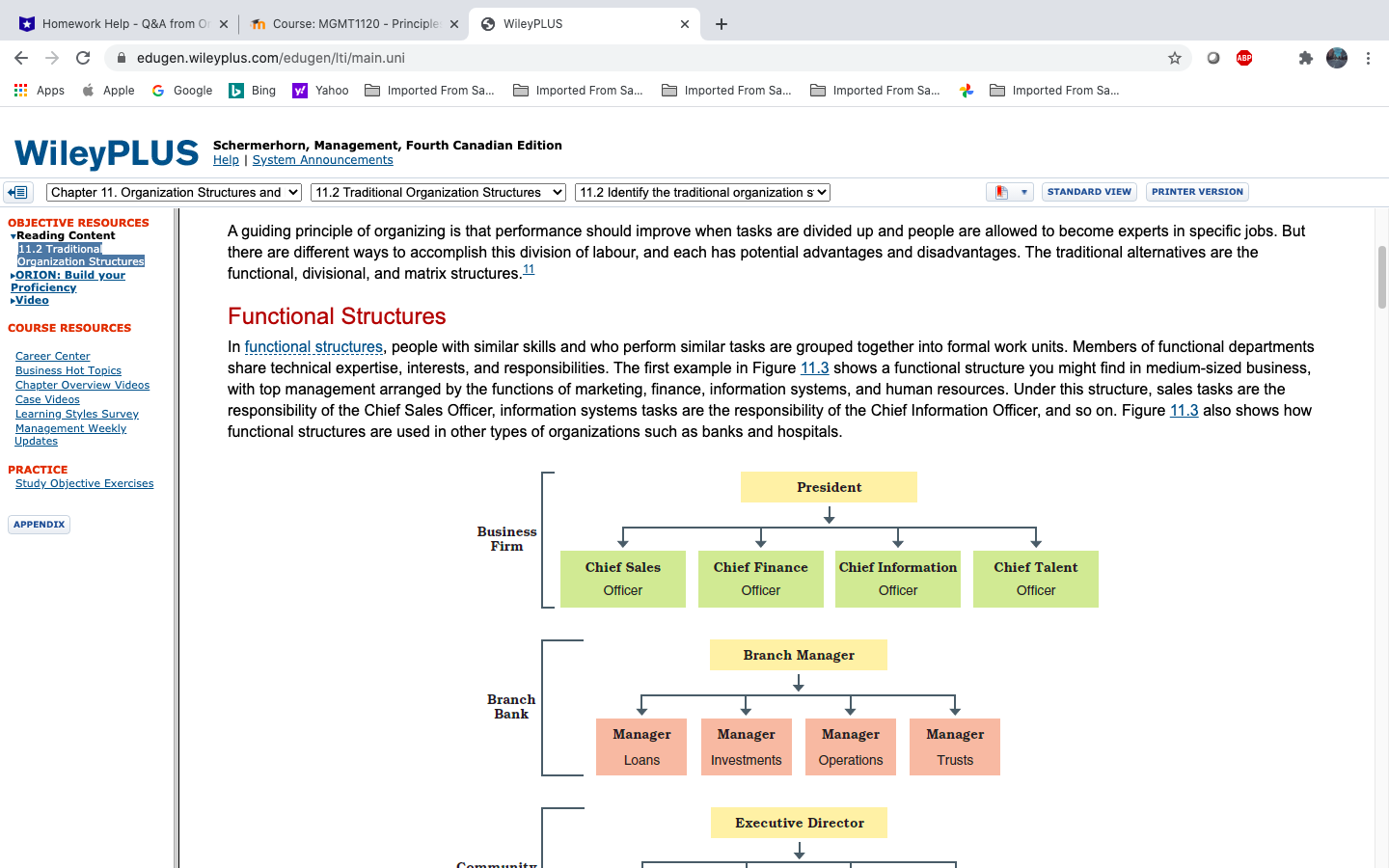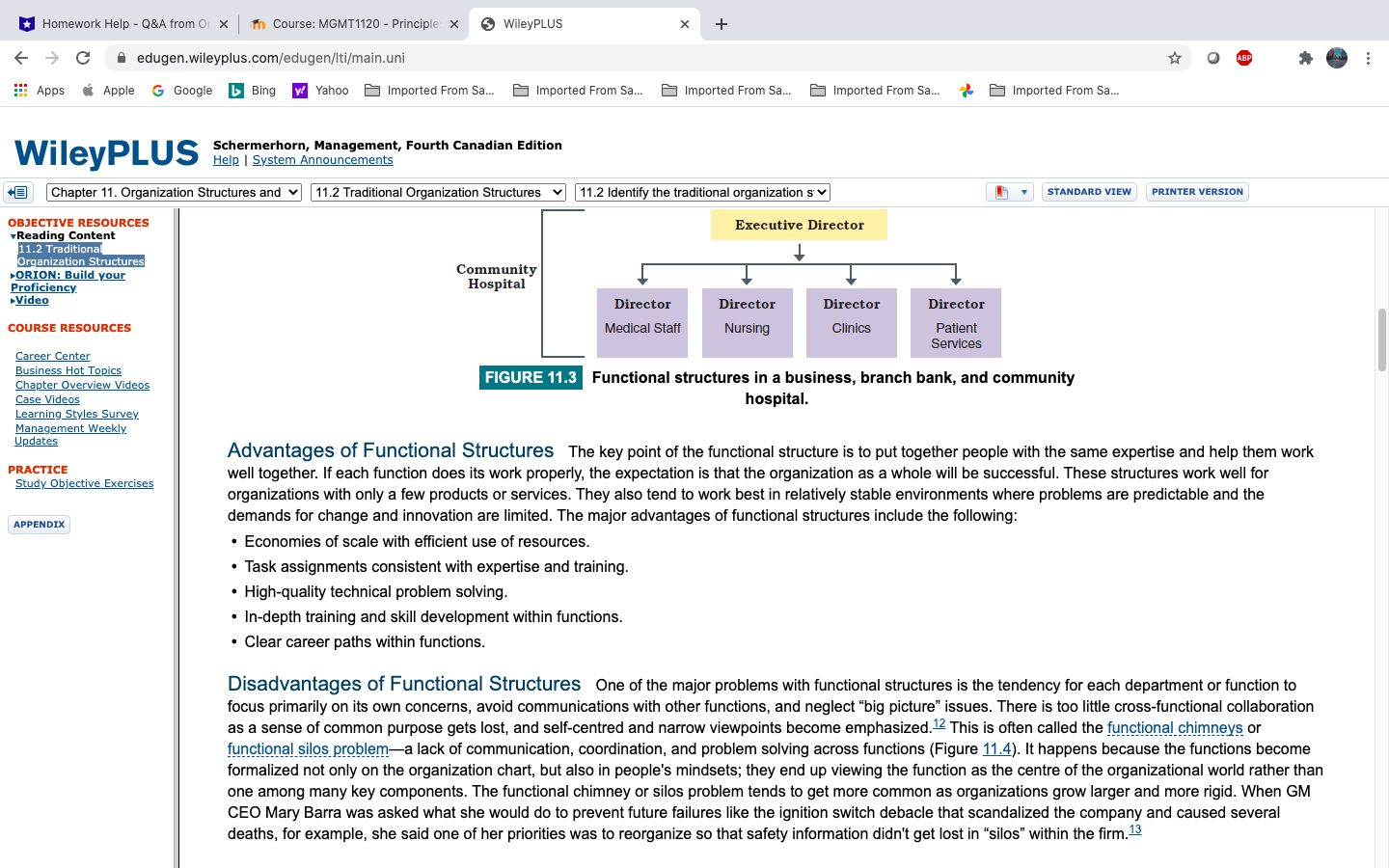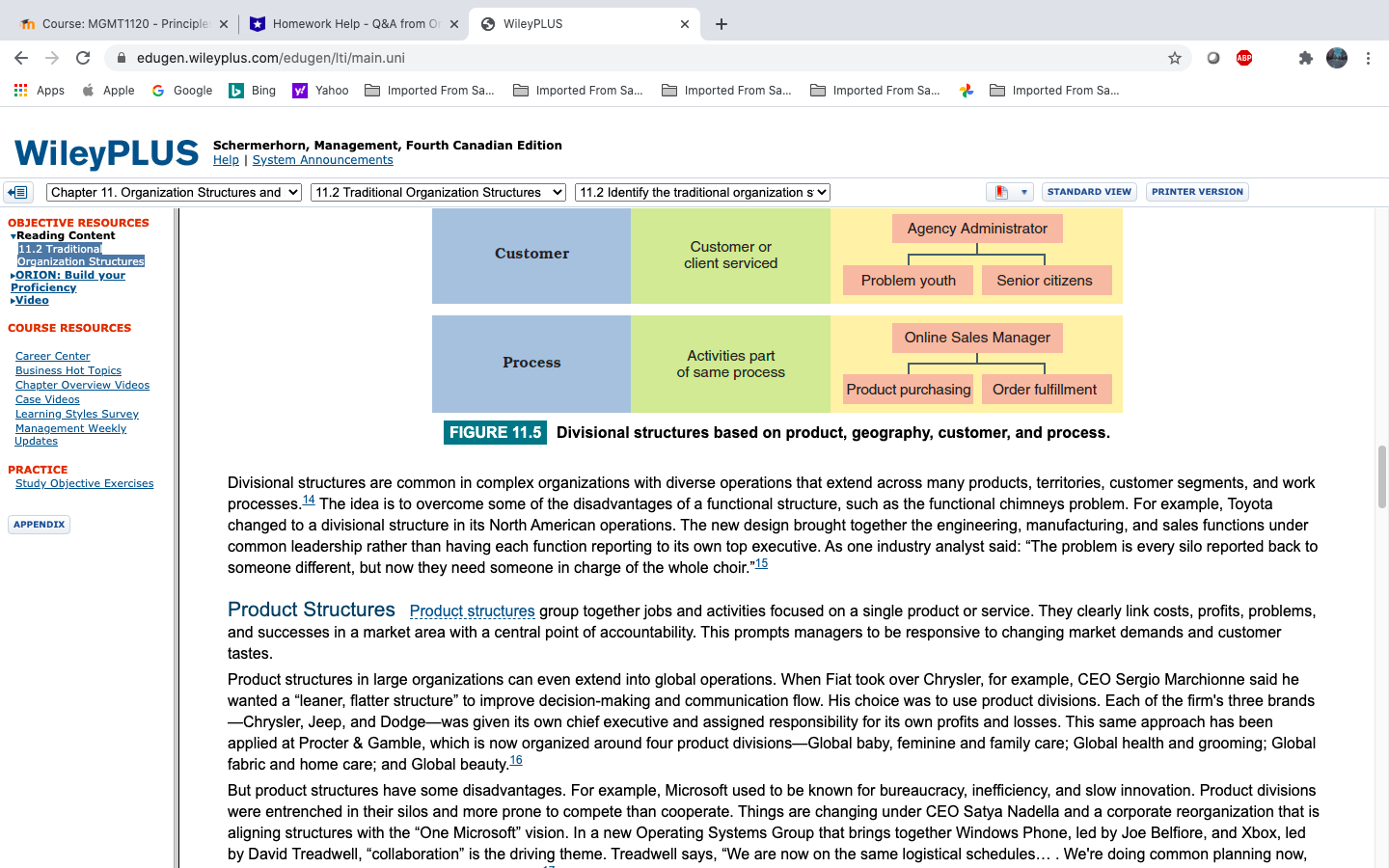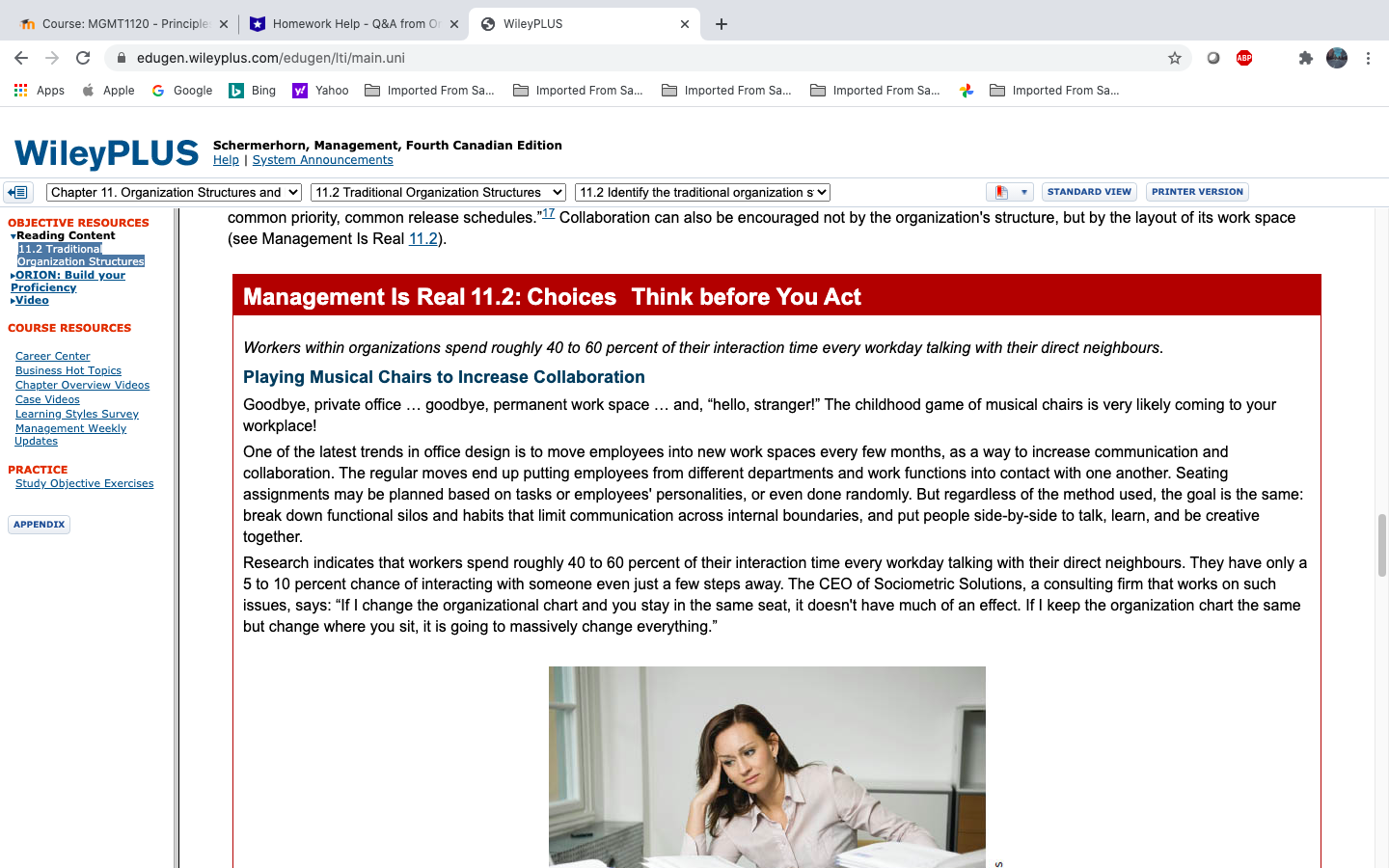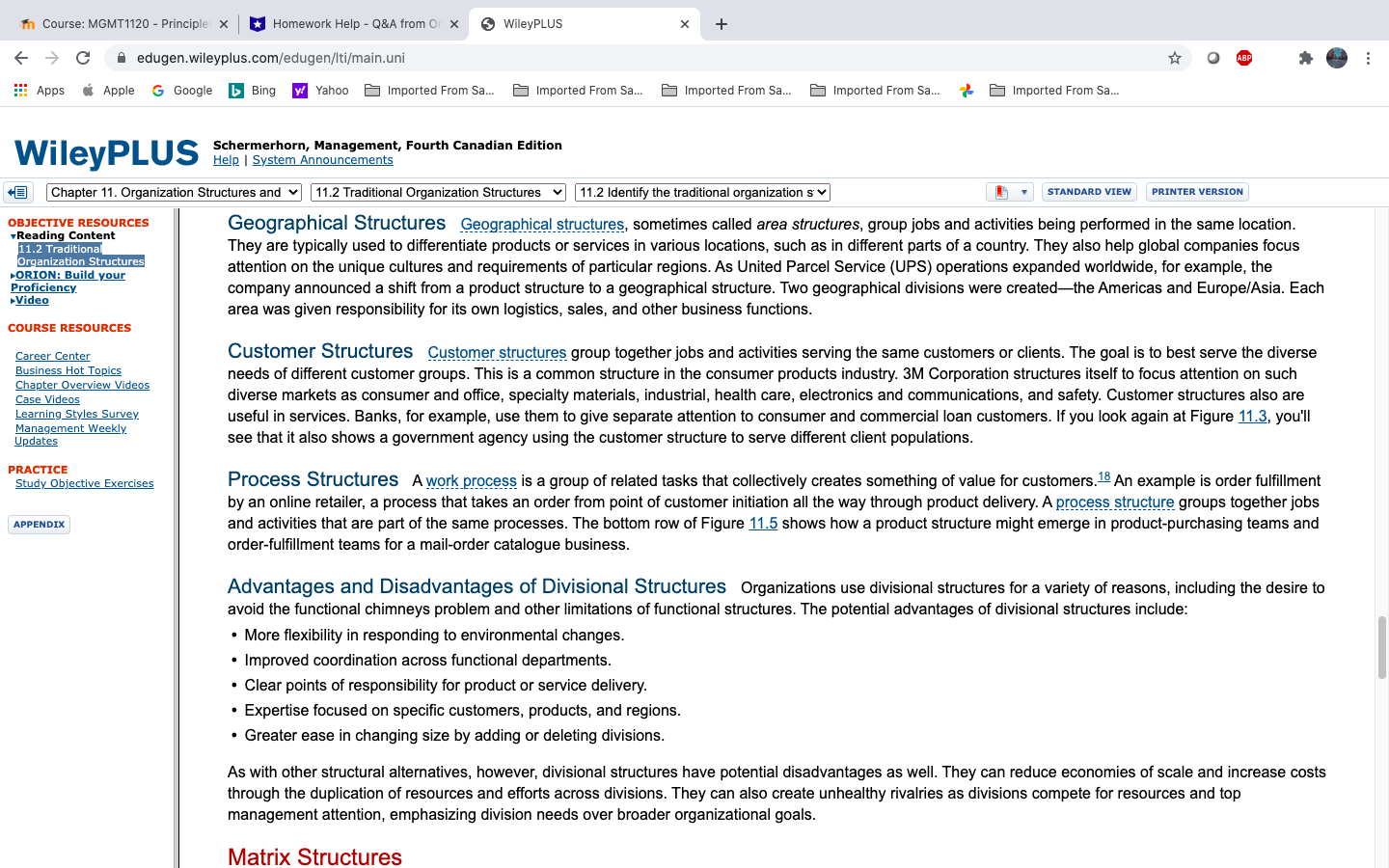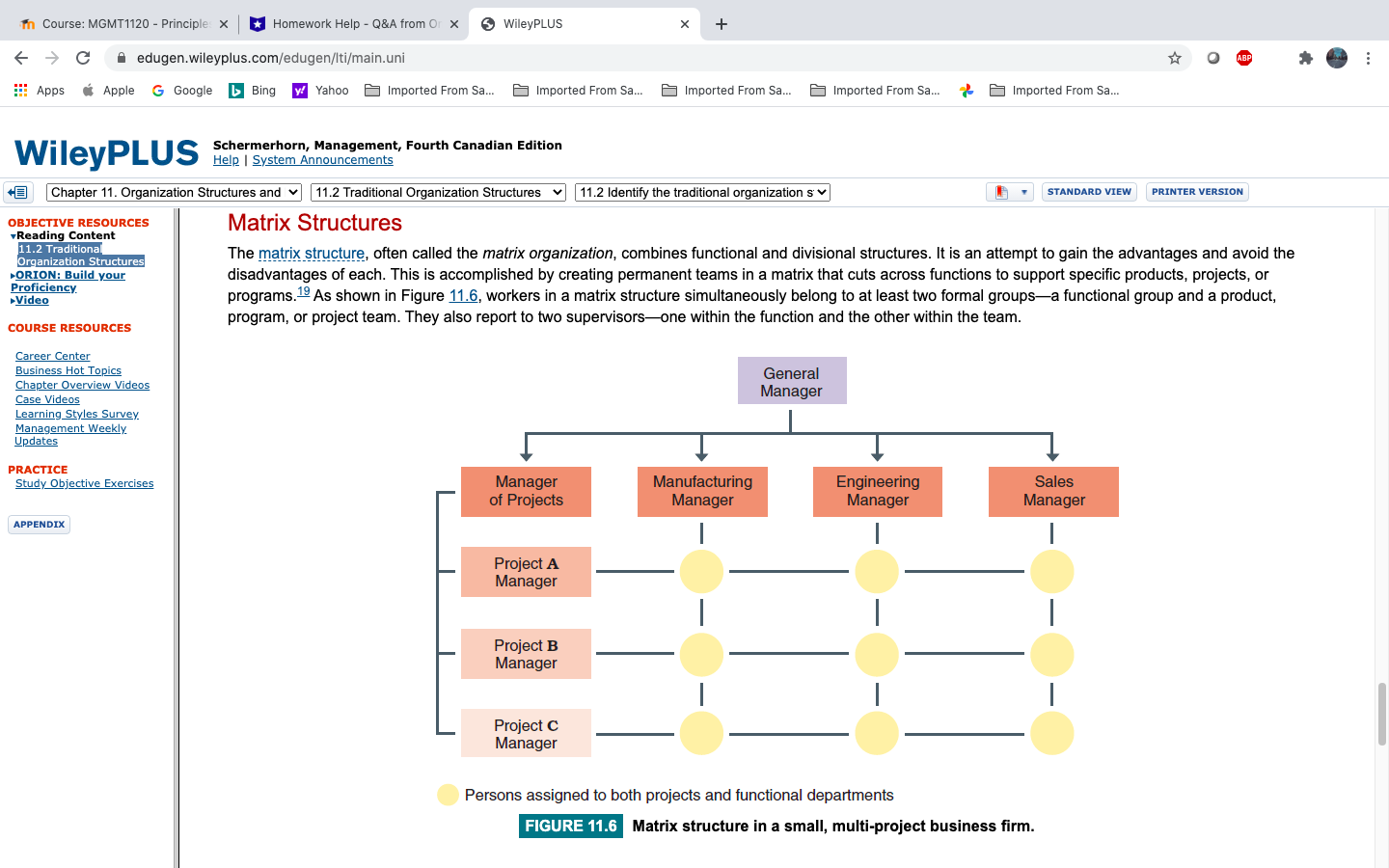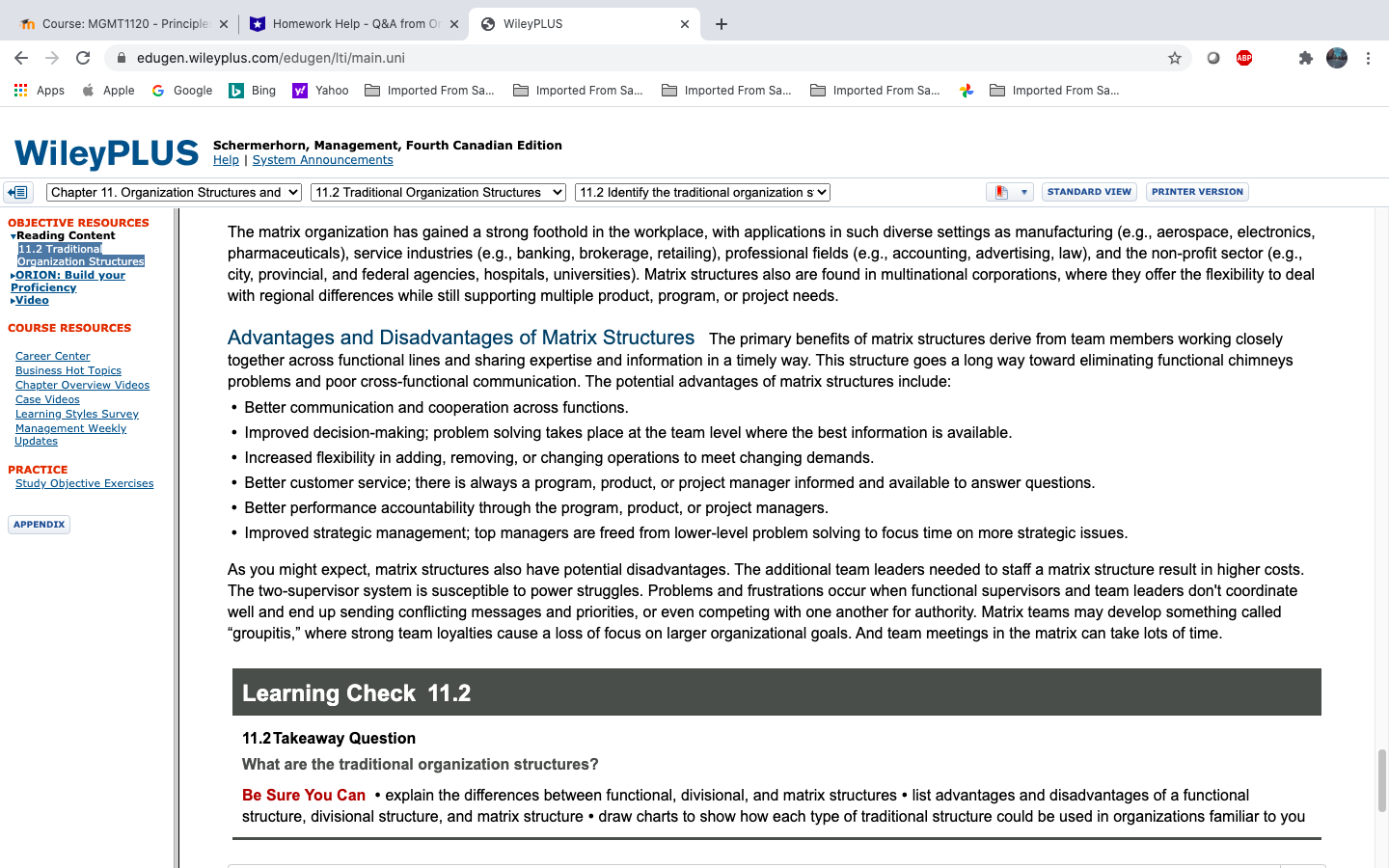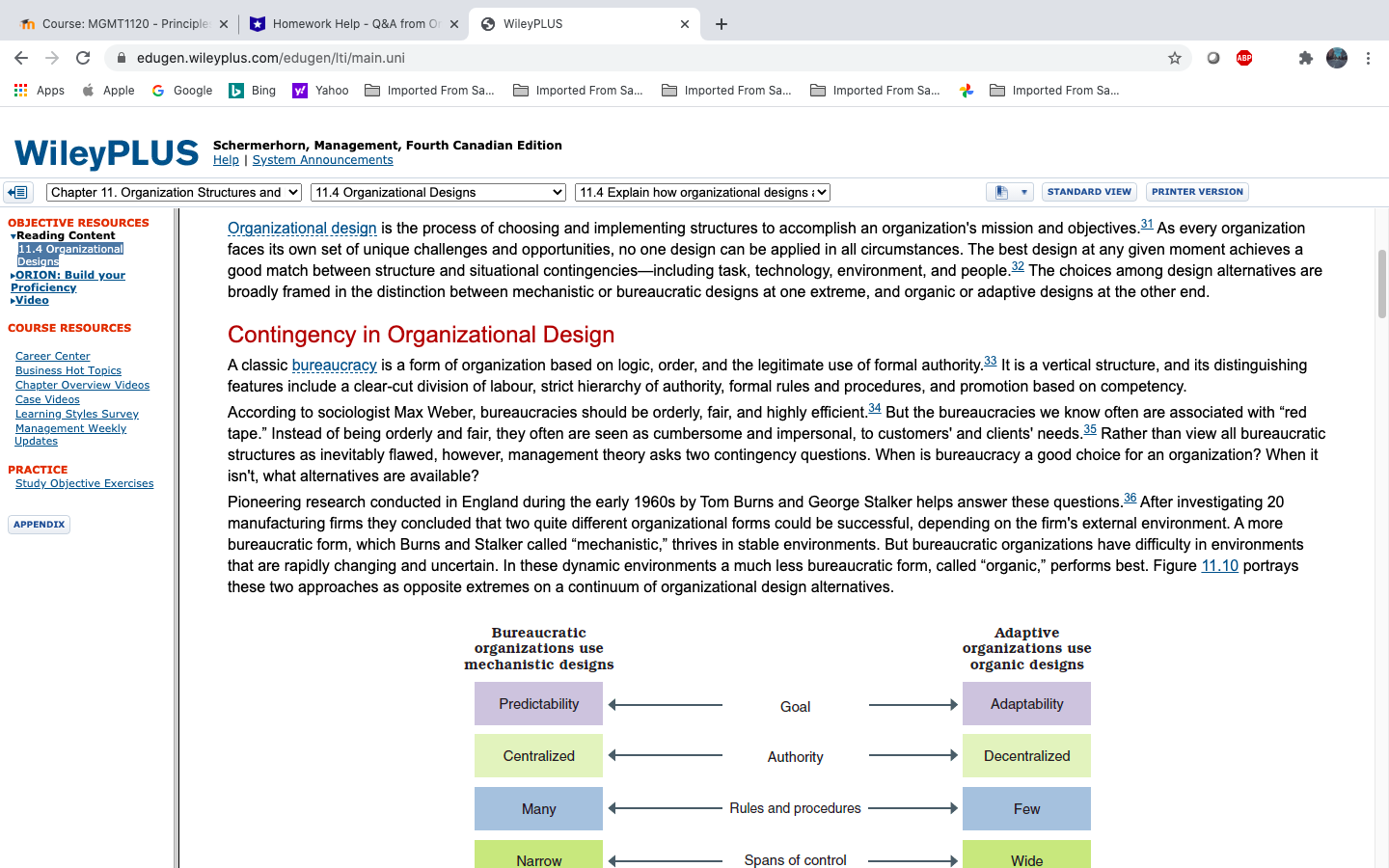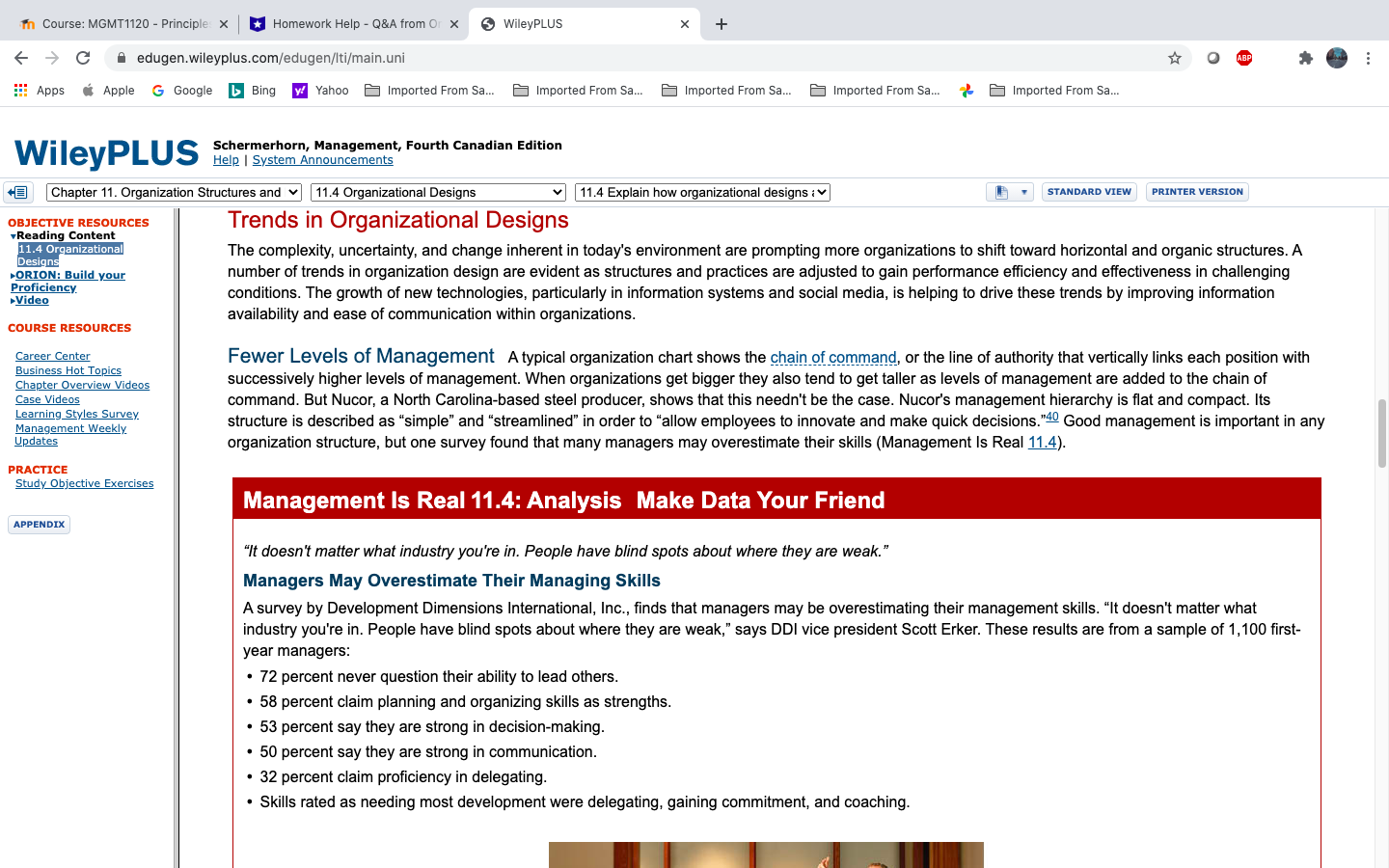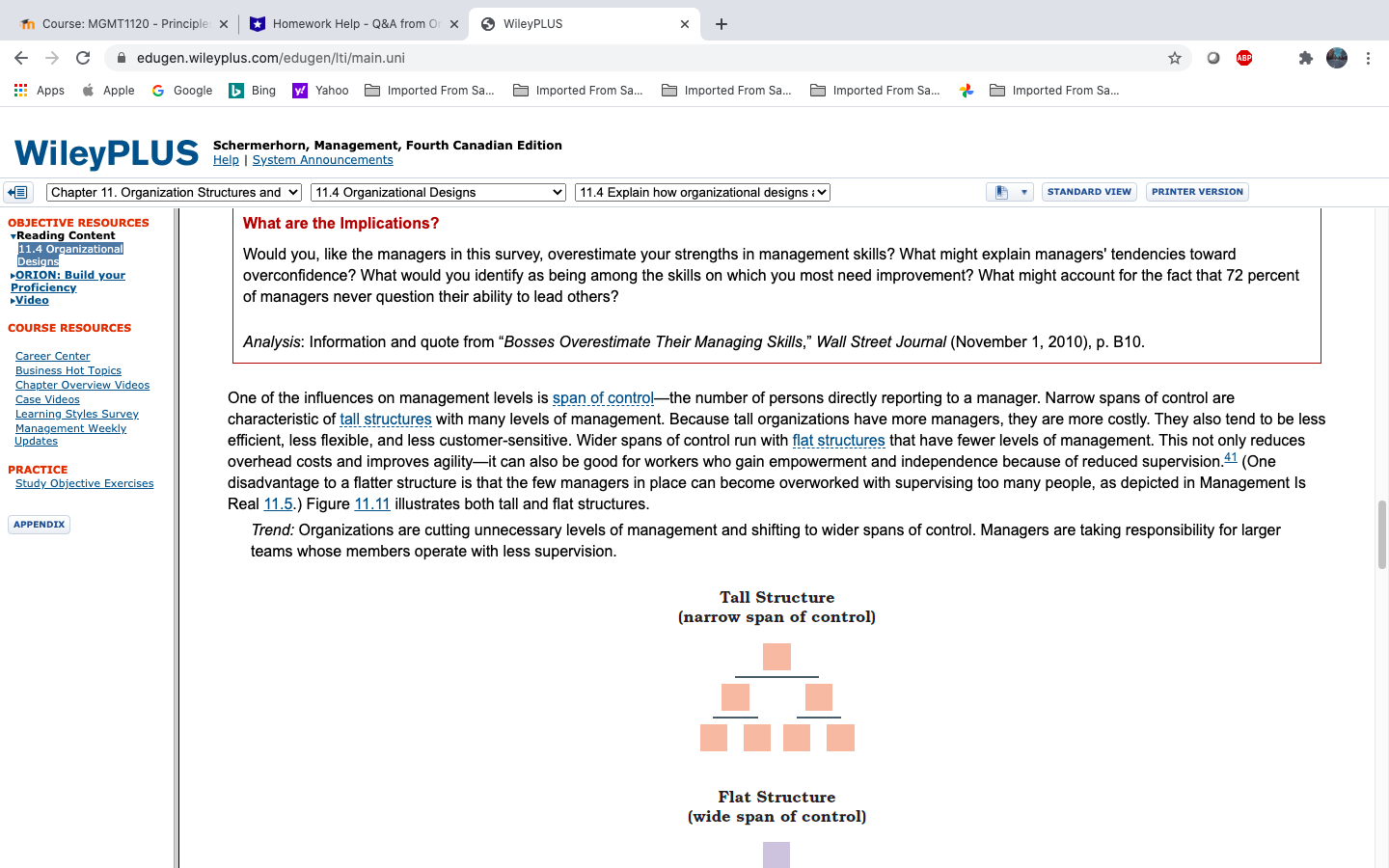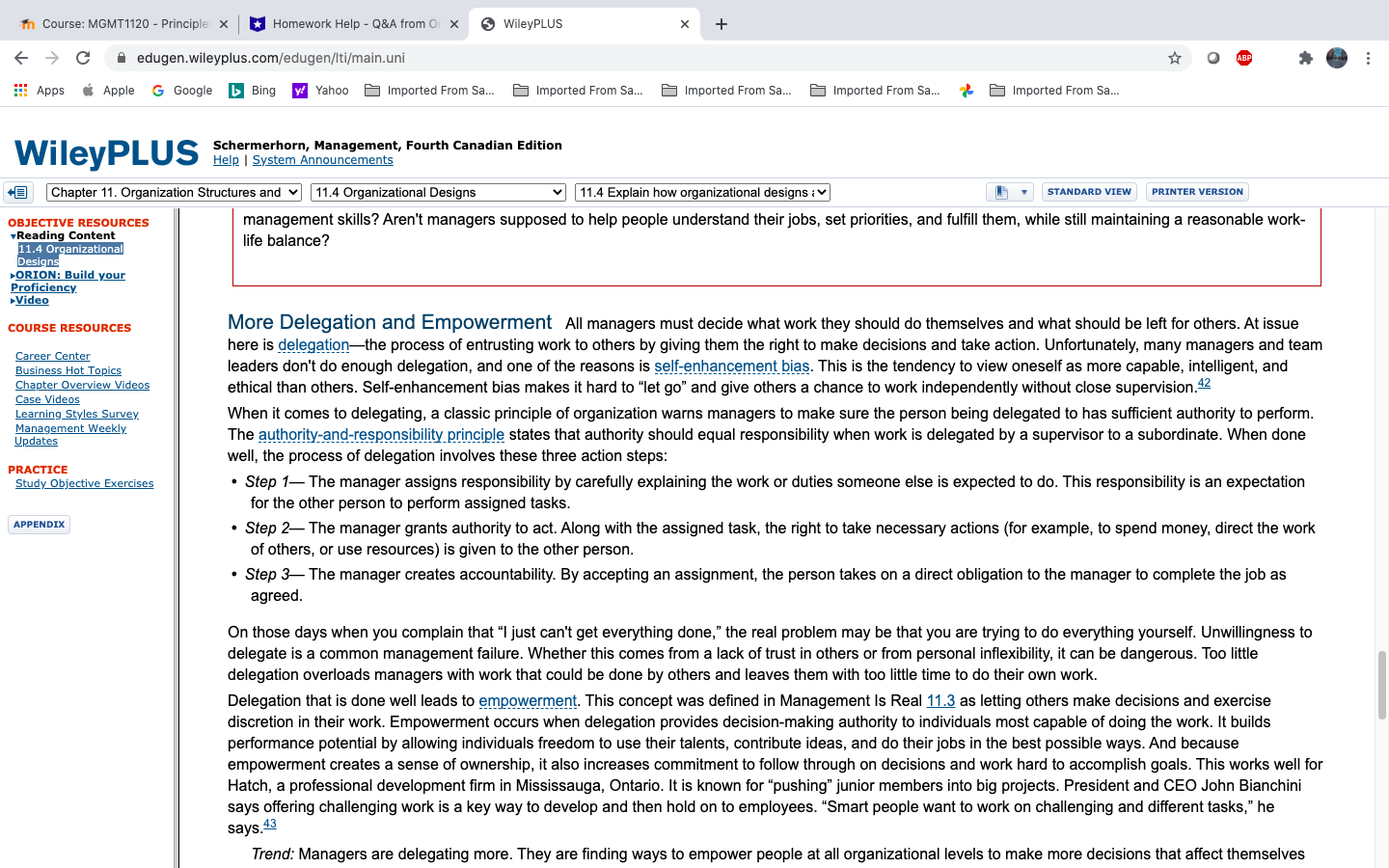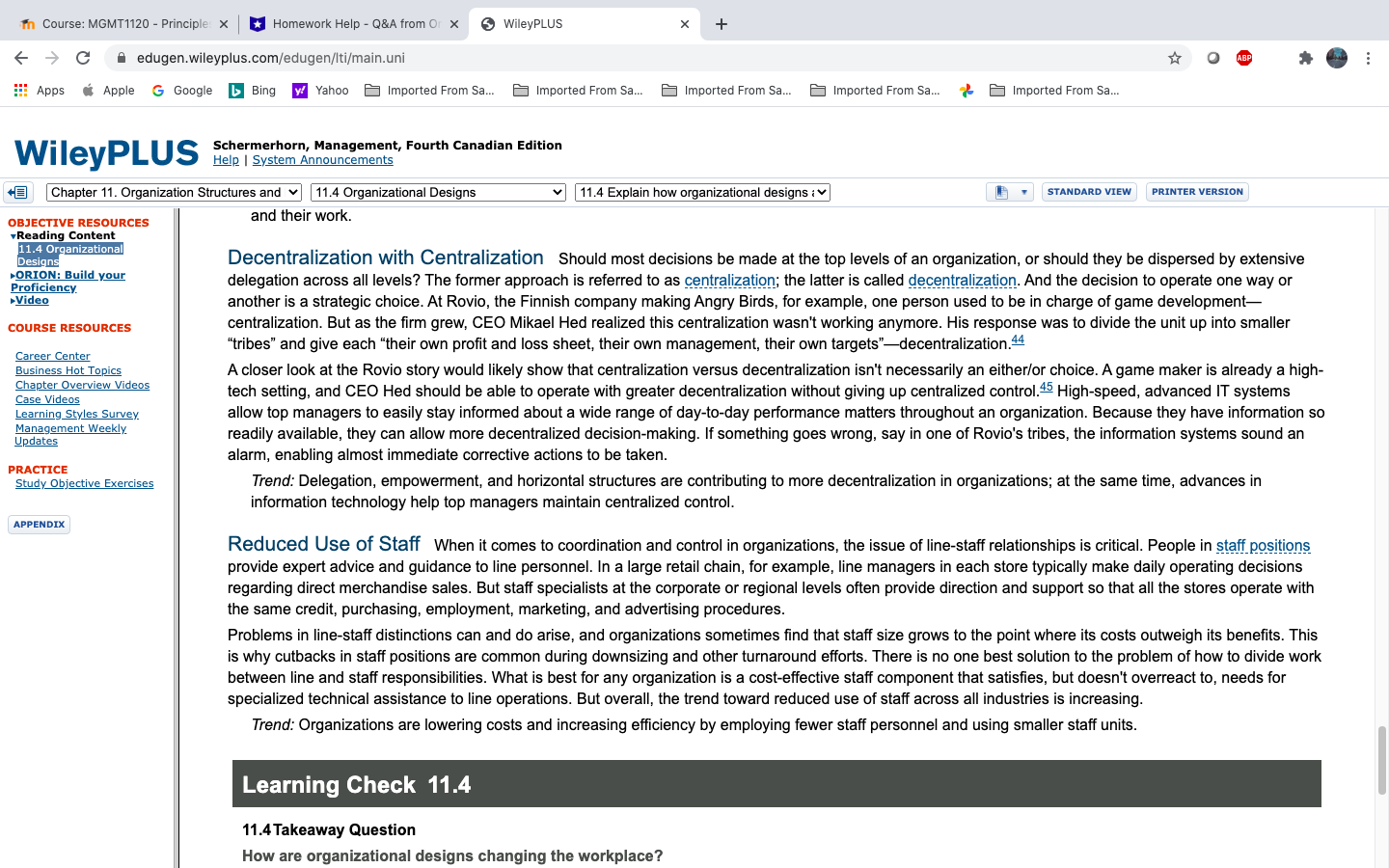1.Using the concepts on page 203 - 207, what type of traditional organizational structure would work the best for Nike?Explain your answer thoroughly. 2.Draw the
1.Using the concepts on page 203 - 207, what type of traditional organizational structure would work the best for Nike?Explain your answer thoroughly.
2.Draw the organizational structure you have chosen for question #1 - be as complete.What improvements could be made to this structure?Explain your choices.
3.Using the concepts on page 211 - 212, which type of organizational design would be the best for Nike? Why?
4.Is Nike on the leading edge of trends in organizational design? Apply the concepts on pp. 212 - 214 to determine leads or lags in implementing new trends in design at Nike.
THE CASE OF NIKE
Where's the Company?
If you don't make anything, what do you actually do? It's not a joke or a Buddhist riddle. Rather, it's a conundrum about one of the most successful companies in the world ?Nike. The company is known worldwide for its products, none of which it actually makes. But if you outsource everything, what's left? The answer, for starters, is a whole lot of brand recognition.
Since captivating the shoe-buying public in the early 1980s with legendary spokesperson Michael Jordan, Nike continues to outpace the athletic shoe competition while spreading its brand through an ever-widening universe of sports equipment, apparel, and paraphernalia. The ever-present Swoosh graces everything from bumper stickers to sunglasses to amateur sports uniforms. Nike products embody a love of sport, discipline, ambition, practice, and other athletic traits.
Outsourcing Wins the Race
Nike has cleverly kept its advertising agency nestled close to home, but has relied extensively on outsourcing many nonexecutive and back-office responsibilities to reduce overhead. The firm is structured around its core competency in product design?not manufacturing. But Nike has taken outsourcing to a new level, with subcontractors producing all of its shoes. Although this hasn't hurt product quality, it has challenged Nike's reputation for social responsibility.
In a move designed to turn critics into converts, Nike posts information on its website detailing every one of the hundreds of factories that it uses to make shoes, apparel, and other sporting goods. It released the data in conjunction with a comprehensive corporate responsibility report summarizing the environmental impact and the labour situations of its contract factories.
Jordan Isn't Forever
Banking on the star power of its Swoosh, Nike has successfully branded apparel, sporting goods, and even sunglasses. Like many large companies that have found themselves at odds with the possible limitations of their brand, Nike realized that it would have to master the one-two punch: identifying new needs and supplying creative and desirable products to fill those needs.
In fitting with the times, Nike's VP of Global Design, John R. Hoke III, encourages his designers to develop environmentally sustainable designs like the Nike Free, a lightweight running shoe that boosted sales dramatically. And Nike's Sustainable Business & Innovation Lab funds outside start-ups focused on alternative energies, more efficient approaches to manufacturing, and the promotion of healthy lifestyles. Nike has even partnered with China's Ministry of Education to help encourage physical activity in Chinese schools. Nike also recently started to market to plus-sized women, and the news was welcomed.
Staying in Front
Pressure is mounting from outside Nike's Beaverton, Oregon, headquarters. German rival Adidas drew a few strides closer to Nike when it purchased Reebok. The new super group of shoes isn't far off from Nike's market size. But when faced with such challenges, Nike simply knocks its bat against its cleats and steps up to the plate. Says Nike spokesman Alan Marks: "Of course we're in a competitive business, but we win by staying focused on our strategies and our consumers. And from that perspective nothing has changed."
Keeping It Together
Nike has so far balanced size and pressure to remain successful by leveraging a decentralized and networked organization structure. Individual business centres?such as research, production, and marketing?are free to focus on their core competencies without worrying about the effects of corporate bloat. The company has found continued marketplace success by positioning itself not simply as a sneaker company but as a brand that fulfills the evolving needs of today's athletes and athletes-at-heart. Will Nike continue to profit from its organization structure, or will it spread itself so thin that its competition will overtake it?
PAGE 203-207 (FROM THE 1-8)
Homework Help - Q&A from Or x In Course: MGMT1120 - Principle: X WileyPLUS X + C A edugen.wileyplus.com/edugen/Iti/main.uni O ABP ... :: Apps Apple G Google L Bing y! Yahoo Imported From Sa.. Imported From Sa. . Imported From Sa. Imported From Sa. * Imported From Sa. WileyPLUS Schermerhorn, Management, Fourth Canadian Edition Help | System Announcements Chapter 11. Organization Structures and | |11.2 Traditional Organization Structures | 11.2 Identify the traditional organization s v STANDARD VIEW PRINTER VERSION OBJECTIVE RESOURCES vReading Content A guiding principle of organizing is that performance should improve when tasks are divided up and people are allowed to become experts in specific jobs. But 11.2 Traditional Organization Structures there are different ways to accomplish this division of labour, and each has potential advantages and disadvantages. The traditional alternatives are the ORION: Build your functional, divisional, and matrix structures. 17 Proficiency Video COURSE RESOURCES Functional Structures Career Center In functional structures, people with similar skills and who perform similar tasks are grouped together into formal work units. Members of functional departments Business Hot Topics share technical expertise, interests, and responsibilities. The first example in Figure 11.3 shows a functional structure you might find in medium-sized business, Chapter Overview Videos with top management arranged by the functions of marketing, finance, information systems, and human resources. Under this structure, sales tasks are the Case Videos Learning Styles Survey responsibility of the Chief Sales Officer, information systems tasks are the responsibility of the Chief Information Officer, and so on. Figure 11.3 also shows how Management Weekly Update functional structures are used in other types of organizations such as banks and hospitals. PRACTICE Study Objective Exercises President APPENDIX Business Firm Chief Sales Chief Finance Chief Information Chief Talent Officer Officer Officer Officer Branch Manager Branch Bank Manager Manager Manager Manager Loans Investments Operations Trusts Executive DirectorHomework Help - Q&A from Or x In Course: MGMT1120 - Principle: X WileyPLUS X + C A edugen.wileyplus.com/edugen/Iti/main.uni O ABP ... :: Apps . Apple G Google L Bing y! Yahoo Imported From Sa.. Imported From Sa. . Imported From Sa. Imported From Sa. * Imported From Sa. WileyPLUS Schermerhorn, Management, Fourth Canadian Edition Help | System Announcements Chapter 11. Organization Structures and | |11.2 Traditional Organization Structures | 11.2 Identify the traditional organization s v STANDARD VIEW PRINTER VERSION OBJECTIVE RESOURCES vReading Content Executive Director 11.2 Traditional Organization Structures .ORION: Build your Community Proficiency Hospital Video Director Director Director Director COURSE RESOURCES Medical Staff Nursing Clinics Patient Services Career Center Business Hot Topics Chapter Overview Videos FIGURE 11.3 Functional structures in a business, branch bank, and community Case Videos hospital. Learning Styles Survey Management Weekly Update Advantages of Functional Structures The key point of the functional structure is to put together people with the same expertise and help them work PRACTICE Study Objective Exercises well together. If each function does its work properly, the expectation is that the organization as a whole will be successful. These structures work well for organizations with only a few products or services. They also tend to work best in relatively stable environments where problems are predictable and the APPENDIX demands for change and innovation are limited. The major advantages of functional structures include the following: . Economies of scale with efficient use of resources. . Task assignments consistent with expertise and training. . High-quality technical problem solving. . In-depth training and skill development within functions. . Clear career paths within functions. Disadvantages of Functional Structures One of the major problems with functional structures is the tendency for each department or function to focus primarily on its own concerns, avoid communications with other functions, and neglect "big picture" issues. There is too little cross-functional collaboration as a sense of common purpose gets lost, and self-centred and narrow viewpoints become emphasized. 2 This is often called the functional chimneys or functional silos problem-a lack of communication, coordination, and problem solving across functions (Figure 11.4). It happens because the functions become formalized not only on the organization chart, but also in people's mindsets; they end up viewing the function as the centre of the organizational world rather than one among many key components. The functional chimney or silos problem tends to get more common as organizations grow larger and more rigid. When GM CEO Mary Barra was asked what she would do to prevent future failures like the ignition switch debacle that scandalized the company and caused several deaths, for example, she said one of her priorities was to reorganize so that safety information didn't get lost in "silos" within the firm. 13In Course: MGMT1120 - Principle: X Homework Help - Q&A from Or x 5 WileyPLUS X + C A edugen.wileyplus.com/edugen/Iti/main.uni O ABP ... : Apps . Apple G Google L Bing y! Yahoo Imported From Sa.. Imported From Sa. . Imported From Sa. Imported From Sa. * Imported From Sa. WileyPLUS Schermerhorn, Management, Fourth Canadian Edition Help | System Announcements Chapter 11. Organization Structures and | |11.2 Traditional Organization Structures |11.2 Identify the traditional organization s v STANDARD VIEW PRINTER VERSION OBJECTIVE RESOURCES vReading Content Functional Chimneys Problem 11.2 Traditional Organization Structures .ORION: Build your Proficiency Video COURSE RESOURCES Career Center Business Hot Topics Chapter Overview Videos Case Videos Learning Styles Survey Management Weekly Update . Too little communication across functions . Too many problems referred upward for solution PRACTICE Study Objective Exercises FIGURE 11.4 The functional chimneys or functional silos problem. APPENDIX Divisional Structures A second organizing alternative is the divisional structure. As illustrated in Figure 11.5, this structure puts together people who work on the same product or process, serve similar customers, or are located in the same area or geographical region. Type Focus Example General Manager Product Good or service produced Grocery products Drugs and toiletries President Geographical Location of activity Asian division European divisionIn Course: MGMT1120 - Principle: X Homework Help - Q&A from Or x 5 WileyPLUS X + C A edugen.wileyplus.com/edugen/Iti/main.uni O ABP ... : Apps . Apple G Google L Bing y! Yahoo Imported From Sa.. Imported From Sa. . Imported From Sa. Imported From Sa. * Imported From Sa. WileyPLUS Schermerhorn, Management, Fourth Canadian Edition Help | System Announcements Chapter 11. Organization Structures and | |11.2 Traditional Organization Structures |11.2 Identify the traditional organization s v . STANDARD VIEW PRINTER VERSION OBJECTIVE RESOURCES vReading Content Agency Administrator 11.2 Traditional Customer Customer or Organization Structures .ORION: Build your client serviced Proficiency Problem youth Senior citizens Video COURSE RESOURCES Online Sales Manager Career Center Activities part Business Hot Topics Process of same process Chapter Overview Videos Case Videos Product purchasing Order fulfillment Learning Styles Survey Management Weekly Update FIGURE 11.5 Divisional structures based on product, geography, customer, and process. PRACTICE Study Objective Exercises Divisional structures are common in complex organizations with diverse operations that extend across many products, territories, customer segments, and work processes. " The idea is to overcome some of the disadvantages of a functional structure, such as the functional chimneys problem. For example, Toyota APPENDIX changed to a divisional structure in its North American operations. The new design brought together the engineering, manufacturing, and sales functions under common leadership rather than having each function reporting to its own top executive. As one industry analyst said: "The problem is every silo reported back to someone different, but now they need someone in charge of the whole choir."15 Product Structures Product structures group together jobs and activities focused on a single product or service. They clearly link costs, profits, problems, and successes in a market area with a central point of accountability. This prompts managers to be responsive to changing market demands and customer tastes. Product structures in large organizations can even extend into global operations. When Fiat took over Chrysler, for example, CEO Sergio Marchionne said he wanted a "leaner, flatter structure" to improve decision-making and communication flow. His choice was to use product divisions. Each of the firm's three brands -Chrysler, Jeep, and Dodge-was given its own chief executive and assigned responsibility for its own profits and losses. This same approach has been applied at Procter & Gamble, which is now organized around four product divisions-Global baby, feminine and family care; Global health and grooming; Global fabric and home care; and Global beauty. 16 But product structures have some disadvantages. For example, Microsoft used to be known for bureaucracy, inefficiency, and slow innovation. Product divisions were entrenched in their silos and more prone to compete than cooperate. Things are changing under CEO Satya Nadella and a corporate reorganization that is aligning structures with the "One Microsoft" vision. In a new Operating Systems Group that brings together Windows Phone, led by Joe Belfiore, and Xbox, led by David Treadwell, "collaboration" is the driving theme. Treadwell says, "We are now on the same logistical schedules... . We're doing common planning now,In Course: MGMT1120 - Principle: X Homework Help - Q&A from Or x 5 WileyPLUS X + C A edugen.wileyplus.com/edugen/Iti/main.uni O ABP ... : Apps . Apple G Google L Bing y! Yahoo Imported From Sa.. Imported From Sa. . Imported From Sa. Imported From Sa. * Imported From Sa. WileyPLUS Schermerhorn, Management, Fourth Canadian Edition Help | System Announcements Chapter 11. Organization Structures and | |11.2 Traditional Organization Structures | |11.2 Identify the traditional organization s v STANDARD VIEW PRINTER VERSION OBJECTIVE RESOURCES common priority, common release schedules." Collaboration can also be encouraged not by the organization's structure, but by the layout of its work space vReading Content 11.2 Traditional (see Management Is Real 11.2). Organization Structures ORION: Build your Proficiency Video Management Is Real 11.2: Choices Think before You Act COURSE RESOURCES Career Center Workers within organizations spend roughly 40 to 60 percent of their interaction time every workday talking with their direct neighbours. Business Hot Topics Chapter Overview Videos Playing Musical Chairs to Increase Collaboration Case Videos Learning Styles Survey Goodbye, private office ... goodbye, permanent work space ... and, "hello, stranger!" The childhood game of musical chairs is very likely coming to your Management Weekly workplace! Update One of the latest trends in office design is to move employees into new work spaces every few months, as a way to increase communication and PRACTICE Study Objective Exercises collaboration. The regular moves end up putting employees from different departments and work functions into contact with one another. Seating assignments may be planned based on tasks or employees' personalities, or even done randomly. But regardless of the method used, the goal is the same: APPENDIX break down functional silos and habits that limit communication across internal boundaries, and put people side-by-side to talk, learn, and be creative together. Research indicates that workers spend roughly 40 to 60 percent of their interaction time every workday talking with their direct neighbours. They have only a 5 to 10 percent chance of interacting with someone even just a few steps away. The CEO of Sociometric Solutions, a consulting firm that works on such issues, says: "If I change the organizational chart and you stay in the same seat, it doesn't have much of an effect. If I keep the organization chart the same but change where you sit, it is going to massively change everything."In Course: MGMT1120 - Principle: X Homework Help - Q&A from Or x 5 WileyPLUS X + C A edugen.wileyplus.com/edugen/Iti/main.uni O ABP ... : Apps Apple G Google L Bing y! Yahoo Imported From Sa.. Imported From Sa. . Imported From Sa. Imported From Sa. * Imported From Sa. WileyPLUS Schermerhorn, Management, Fourth Canadian Edition Help | System Announcements Chapter 11. Organization Structures and | |11.2 Traditional Organization Structures | |11.2 Identify the traditional organization s v STANDARD VIEW PRINTER VERSION OBJECTIVE RESOURCES vReading Content Geographical Structures Geographical structures, sometimes called area structures, group jobs and activities being performed in the same location. 11.2 Traditional They are typically used to differentiate products or services in various locations, such as in different parts of a country. They also help global companies focus Organization Structures ORION: Build your attention on the unique cultures and requirements of particular regions. As United Parcel Service (UPS) operations expanded worldwide, for example, the Proficiency Video company announced a shift from a product structure to a geographical structure. Two geographical divisions were created-the Americas and Europe/Asia. Each area was given responsibility for its own logistics, sales, and other business functions. COURSE RESOURCES Career Center Customer Structures Customer structures group together jobs and activities serving the same customers or clients. The goal is to best serve the diverse Business Hot Topics Chapter Overview Videos needs of different customer groups. This is a common structure in the consumer products industry. 3M Corporation structures itself to focus attention on such Case Videos diverse markets as consumer and office, specialty materials, industrial, health care, electronics and communications, and safety. Customer structures also are Learning Styles Survey Management Weekly useful in services. Banks, for example, use them to give separate attention to consumer and commercial loan customers. If you look again at Figure 11.3, you'll Update see that it also shows a government agency using the customer structure to serve different client populations. PRACTICE Study Objective Exercises Process Structures A work process is a group of related tasks that collectively creates something of value for customers. " An example is order fulfillment by an online retailer, a process that takes an order from point of customer initiation all the way through product delivery. A process structure groups together jobs APPENDIX and activities that are part of the same processes. The bottom row of Figure 11.5 shows how a product structure might emerge in product-purchasing teams and order-fulfillment teams for a mail-order catalogue business. Advantages and Disadvantages of Divisional Structures Organizations use divisional structures for a variety of reasons, including the desire to avoid the functional chimneys problem and other limitations of functional structures. The potential advantages of divisional structures include: . More flexibility in responding to environmental changes. . Improved coordination across functional departments. . Clear points of responsibility for product or service delivery. . Expertise focused on specific customers, products, and regions. . Greater ease in changing size by adding or deleting divisions. As with other structural alternatives, however, divisional structures have potential disadvantages as well. They can reduce economies of scale and increase costs through the duplication of resources and efforts across divisions. They can also create unhealthy rivalries as divisions compete for resources and top management attention, emphasizing division needs over broader organizational goals. Matrix StructuresIn Course: MGMT1120 - Principle: X Homework Help - Q&A from Or x 5 WileyPLUS X + C A edugen.wileyplus.com/edugen/Iti/main.uni O ABP ... : Apps . Apple G Google L Bing y! Yahoo Imported From Sa.. Imported From Sa. . Imported From Sa. Imported From Sa. * Imported From Sa. WileyPLUS Schermerhorn, Management, Fourth Canadian Edition Help | System Announcements Chapter 11. Organization Structures and | |11.2 Traditional Organization Structures |11.2 Identify the traditional organization s v STANDARD VIEW PRINTER VERSION OBJECTIVE RESOURCES vReading Content Matrix Structures 11.2 Traditional Organization Structures The matrix structure, often called the matrix organization, combines functional and divisional structures. It is an attempt to gain the advantages and avoid the ORION: Build your disadvantages of each. This is accomplished by creating permanent teams in a matrix that cuts across functions to support specific products, projects, or Proficiency Video programs.19 As shown in Figure 11.6, workers in a matrix structure simultaneously belong to at least two formal groups-a functional group and a product, COURSE RESOURCES program, or project team. They also report to two supervisors-one within the function and the other within the team. Career Center Business Hot Topics General Chapter Overview Videos Case Videos Manager Learning Styles Survey Management Weekly Update PRACTICE Study Objective Exercises Manager Manufacturing Engineering Sales of Projects Manager Manager Manager APPENDIX Project A Manager Project B Manager Project C Manager Persons assigned to both projects and functional departments FIGURE 11.6 Matrix structure in a small, multi-project business firm.In Course: MGMT1120 - Principle: X Homework Help - Q&A from Or x 5 WileyPLUS X + C A edugen.wileyplus.com/edugen/Iti/main.uni O ABP ... : Apps . Apple G Google L Bing y! Yahoo Imported From Sa.. Imported From Sa. . Imported From Sa.. Imported From Sa. Imported From Sa. WileyPLUS Schermerhorn, Management, Fourth Canadian Edition Help | System Announcements Chapter 11. Organization Structures and | |11.2 Traditional Organization Structures | 11.2 Identify the traditional organization s v STANDARD VIEW PRINTER VERSION OBJECTIVE RESOURCES vReading Content The matrix organization has gained a strong foothold in the workplace, with applications in such diverse settings as manufacturing (e.g., aerospace, electronics, 11.2 Traditional Organization Structures pharmaceuticals), service industries (e.g., banking, brokerage, retailing), professional fields (e.g., accounting, advertising, law), and the non-profit sector (e.g., ORION: Build your Proficiency city, provincial, and federal agencies, hospitals, universities). Matrix structures also are found in multinational corporations, where they offer the flexibility to deal Video with regional differences while still supporting multiple product, program, or project needs. COURSE RESOURCES Advantages and Disadvantages of Matrix Structures The primary benefits of matrix structures derive from team members working closely Career Center Business Hot Topics together across functional lines and sharing expertise and information in a timely way. This structure goes a long way toward eliminating functional chimneys Chapter Overview Videos problems and poor cross-functional communication. The potential advantages of matrix structures include: Case Videos Learning Styles Survey . Better communication and cooperation across functions. Management Weekly Update . Improved decision-making; problem solving takes place at the team level where the best information is available. PRACTICE . Increased flexibility in adding, removing, or changing operations to meet changing demands. Study Objective Exercises . Better customer service; there is always a program, product, or project manager informed and available to answer questions. . Better performance accountability through the program, product, or project managers. APPENDIX . Improved strategic management; top managers are freed from lower-level problem solving to focus time on more strategic issues. As you might expect, matrix structures also have potential disadvantages. The additional team leaders needed to staff a matrix structure result in higher costs. The two-supervisor system is susceptible to power struggles. Problems and frustrations occur when functional supervisors and team leaders don't coordinate well and end up sending conflicting messages and priorities, or even competing with one another for authority. Matrix teams may develop something called "groupitis," where strong team loyalties cause a loss of focus on larger organizational goals. And team meetings in the matrix can take lots of time. Learning Check 11.2 11.2 Takeaway Question What are the traditional organization structures? Be Sure You Can . explain the differences between functional, divisional, and matrix structures . list advantages and disadvantages of a functional structure, divisional structure, and matrix structure . draw charts to show how each type of traditional structure could be used in organizations familiar to youIn Course: MGMT1120 - Principle: X Homework Help - Q&A from Or x 5 WileyPLUS X + C A edugen.wileyplus.com/edugen/Iti/main.uni O ABP ... : Apps . Apple G Google L Bing y! Yahoo Imported From Sa.. Imported From Sa. . Imported From Sa.. Imported From Sa.. * Imported From Sa. WileyPLUS Schermerhorn, Management, Fourth Canadian Edition Help | System Announcements Chapter 11. Organization Structures and | |11.4 Organizational Designs v 11.4 Explain how organizational designs : v STANDARD VIEW PRINTER VERSION OBJECTIVE RESOURCES vReading Content Organizational design is the process of choosing and implementing structures to accomplish an organization's mission and objectives. As every organization 11.4 Organizational Designs faces its own set of unique challenges and opportunities, no one design can be applied in all circumstances. The best design at any given moment achieves a ORION: Build your good match between structure and situational contingencies-including task, technology, environment, and people. The choices among design alternatives are Proficiency -Video broadly framed in the distinction between mechanistic or bureaucratic designs at one extreme, and organic or adaptive designs at the other end. COURSE RESOURCES Contingency in Organizational Design Career Center Business Hot Topics A classic bureaucracy is a form of organization based on logic, order, and the legitimate use of formal authority. It is a vertical structure, and its distinguishing Chapter Overview Videos Case Videos features include a clear-cut division of labour, strict hierarchy of authority, formal rules and procedures, and promotion based on competency. Learning Styles Survey According to sociologist Max Weber, bureaucracies should be orderly, fair, and highly efficient. But the bureaucracies we know often are associated with "red Management Weekly Update tape." Instead of being orderly and fair, they often are seen as cumbersome and impersonal, to customers' and clients' needs.$5 Rather than view all bureaucratic PRACTICE structures as inevitably flawed, however, management theory asks two contingency questions. When is bureaucracy a good choice for an organization? When it Study Objective Exercises isn't, what alternatives are available? Pioneering research conducted in England during the early 1960s by Tom Burns and George Stalker helps answer these questions. After investigating 20 APPENDIX manufacturing firms they concluded that two quite different organizational forms could be successful, depending on the firm's external environment. A more bureaucratic form, which Burns and Stalker called "mechanistic," thrives in stable environments. But bureaucratic organizations have difficulty in environments that are rapidly changing and uncertain. In these dynamic environments a much less bureaucratic form, called "organic," performs best. Figure 11.10 portrays these two approaches as opposite extremes on a continuum of organizational design alternatives. Bureaucratic Adaptive organizations use organizations use mechanistic designs organic designs Predictability Goal Adaptability Centralized Authority Decentralized Many Rules and procedures Few Narrow Spans of control WideIn Course: MGMT1120 - Principle: X Homework Help - Q&A from Or x 5 WileyPLUS X + C A edugen.wileyplus.com/edugen/Iti/main.uni O ABP ... : Apps . Apple G Google L Bing y! Yahoo Imported From Sa.. Imported From Sa. . Imported From Sa.. Imported From Sa. * Imported From Sa. WileyPLUS Schermerhorn, Management, Fourth Canadian Edition Help | System Announcements Chapter 11. Organization Structures and | |11.4 Organizational Designs v 11.4 Explain how organizational designs : v STANDARD VIEW PRINTER VERSION OBJECTIVE RESOURCES Specialized Tasks Shared vReading Content 11.4 Organizational Designs ORION: Build your Few Many Proficiency Teams and task forces -Video COURSE RESOURCES Formal and Informal and impersonal Coordination personal Career Center Business Hot Topics Chapter Overview Videos FIGURE 11.10 Organizational design alternatives: From bureaucratic to adaptive Case Videos organizations. Learning Styles Survey Management Weekly Update Mechanistic and Organic Designs PRACTICE Study Objective Exercises Organizations with more mechanistic designs are highly bureaucratic. They are vertical structures that typically operate with centralized authority, many rules and procedures, a precise division of labour, narrow spans of control, and formal coordination. They can be described as "tight" structures of the traditional pyramid APPENDIX form. 37 Mechanistic designs work best for organizations doing routine tasks in stable environments. A local fast-food restaurant is a good example. Each store is a relatively small operation that operates much like others in the franchise chain and according to rules established by the corporate management. Service personnel work in orderly and disciplined ways, guided by training, rules, and procedures, and by close supervision of crew leaders who work alongside them. Even personal appearance is carefully regulated, with everyone working in uniform. This mechanistic design performs well as it repetitively delivers items that are part of a standard menu. You quickly discover the design limits, however, if you try to order something not on the menu. The chains also are slow to adjust when consumer tastes change. When organizations are in dynamic and uncertain environments, their effectiveness depends on being able to adapt quickly to changing customer tastes and preferences. This requires the more organic designs described in Figure 11.10." These are horizontal structures that operate with decentralized authority, fewer rules and procedures, less precise division of labour, wider spans of control, and more personal means of coordination. Organic designs create adaptive organizations that can perform well in environments that demand flexibility in dealing with changing conditions. They are relatively "loose" systems where a lot of work gets done through informal structures and networking.They are built on a foundation of trust that gives employees the freedom to use their own ideas and expertise to do things on their own initiative, and without waiting for orders from a "boss." This means giving workers freedom to get the job done. Trends in Organizational DesignsIn Course: MGMT1120 - Principle: X Homework Help - Q&A from Or x 5 WileyPLUS X + C A edugen.wileyplus.com/edugen/Iti/main.uni O ABP ... : Apps . Apple G Google b Bing y! Yahoo Imported From Sa... Imported From Sa. . Imported From Sa. Imported From Sa. * Imported From Sa. WileyPLUS Schermerhorn, Management, Fourth Canadian Edition Help | System Announcements Chapter 11. Organization Structures and | |11.4 Organizational Designs v 11.4 Explain how organizational designs : v STANDARD VIEW PRINTER VERSION OBJECTIVE RESOURCES vReading Content Trends in Organizational Designs 11.4 Organizational Designs The complexity, uncertainty, and change inherent in today's environment are prompting more organizations to shift toward horizontal and organic structures. A ORION: Build your number of trends in organization design are evident as structures and practices are adjusted to gain performance efficiency and effectiveness in challenging Proficiency -Video conditions. The growth of new technologies, particularly in information systems and social media, is helping to drive these trends by improving information COURSE RESOURCES availability and ease of communication within organizations. Career Center Business Hot Topics Fewer Levels of Management A typical organization chart shows the chain of command, or the line of authority that vertically links each position with Chapter Overview Videos successively higher levels of management. When organizations get bigger they also tend to get taller as levels of management are added to the chain of Case Videos command. But Nucor, a North Carolina-based steel producer, shows that this needn't be the case. Nucor's management hierarchy is flat and compact. Its Learning Styles Survey Management Weekly structure is described as "simple" and "streamlined" in order to "allow employees to innovate and make quick decisions." Good management is important in any Update organization structure, but one survey found that many managers may overestimate their skills (Management Is Real 11.4). PRACTICE Study Objective Exercises Management Is Real 11.4: Analysis Make Data Your Friend APPENDIX "It doesn't matter what industry you're in. People have blind spots about where they are weak." Managers May Overestimate Their Managing Skills A survey by Development Dimensions International, Inc., finds that managers may be overestimating their management skills. "It doesn't matter what industry you're in. People have blind spots about where they are weak," says DDI vice president Scott Erker. These results are from a sample of 1, 100 first- year managers: . 72 percent never question their ability to lead others . 58 percent claim planning and organizing skills as strengths. . 53 percent say they are strong in decision-making. . 50 percent say they are strong in communication. . 32 percent claim proficiency in delegating. . Skills rated as needing most development were delegating, gaining commitment, and coaching.In Course: MGMT1120 - Principle: X Homework Help - Q&A from Or x 5 WileyPLUS X + C A edugen.wileyplus.com/edugen/Iti/main.uni O ABP ... : Apps . Apple G Google L Bing y! Yahoo Imported From Sa.. Imported From Sa. . Imported From Sa. Imported From Sa. * Imported From Sa. WileyPLUS Schermerhorn, Management, Fourth Canadian Edition Help | System Announcements Chapter 11. Organization Structures and | |11.4 Organizational Designs v 11.4 Explain how organizational designs : v STANDARD VIEW PRINTER VERSION OBJECTIVE RESOURCES vReading Content What are the Implications? 11.4 Organizational Designs Would you, like the managers in this survey, overestimate your strengths in management skills? What might explain managers' tendencies toward ORION: Build your Proficiency overconfidence? What would you identify as being among the skills on which you most need improvement? What might account for the fact that 72 percent -Video of managers never question their ability to lead others? COURSE RESOURCES Career Center Analysis: Information and quote from "Bosses Overestimate Their Managing Skills," Wall Street Journal (November 1, 2010), p. B10. Business Hot Topics Chapter Overview Videos Case Videos One of the influences on management levels is span of control-the number of persons directly reporting to a manager. Narrow spans of control are Learning Styles Survey Management Weekly characteristic of tall structures with many levels of management. Because tall organizations have more managers, they are more costly. They also tend to be less Update efficient, less flexible, and less customer-sensitive. Wider spans of control run with flat structures that have fewer levels of management. This not only reduces PRACTICE overhead costs and improves agility-it can also be good for workers who gain empowerment and independence because of reduced supervision. (One Study Objective Exercises disadvantage to a flatter structure is that the few managers in place can become overworked with supervising too many people, as depicted in Management Is Real 11.5.) Figure 11.11 illustrates both tall and flat structures. APPENDIX Trend: Organizations are cutting unnecessary levels of management and shifting to wider spans of control. Managers are taking responsibility for larger teams whose members operate with less supervision. Tall Structure (narrow span of control) Flat Structure (wide span of control)In Course: MGMT1120 - Principle: X Homework Help - Q&A from Or x 5 WileyPLUS X + C A edugen.wileyplus.com/edugen/Iti/main.uni O ABP ... : Apps . Apple G Google L Bing y! Yahoo Imported From Sa.. Imported From Sa. . Imported From Sa. Imported From Sa. * Imported From Sa. WileyPLUS Schermerhorn, Management, Fourth Canadian Edition Help | System Announcements Chapter 11. Organization Structures and | |11.4 Organizational Designs 11.4 Explain how organizational designs : v STANDARD VIEW PRINTER VERSION OBJECTIVE RESOURCES vReading Content 11.4 Organizational Designs FIGURE 11.11 Different chains of ORION: Build your command. Proficiency -Video COURSE RESOURCES Career Center Management Is Real 11.5: Ethics Know Right from Wrong Business Hot Topics Chapter Overview Videos Case Videos "I even feel guilty now taking time to watch my daughter play soccer on Saturday mornings." Learning Styles Survey Management Weekly Help! I've Been Flattened into Exhaustion Update Dear Stress Doctor: PRACTICE Study Objective Exercises My boss came up with the great idea of laying off some managers, assigning more workers to those of us who haven't been laid off, and calling us "coaches" instead of supervisors. She says this is all part of a new management approach to operate with a flatter structure and more empowerment. APPENDIX For me this means a lot more work coordinating the activities of 17 operators instead of the 6 that I previously supervised. I can't get everything cleaned up on my desk most days, and I end up taking a lot of work home. As my organization "restructures" and cuts back staff, it puts a greater burden on the rest of us. We get exhausted, and our families get short-changed and angry. I even feel guilty now taking time to watch my daughter play soccer on Saturday mornings. Sure, there's some decent pay involved, but that doesn't make up for the heavy price in terms of lost family time. But you know what? My boss doesn't get it. I never hear her ask: "Camille, are you working too much? Don't you think it's time to get back on a reasonable schedule?" No! What I often hear instead is "Look at Andy; he handles our new management model really well, and he's a real go-getter. I don't think he's been out of here one night this week before 8 PM.' What am I going to do, just keep it up until everything falls apart one day? Is a flatter structure with fewer managers always best? Am I missing something here with the whole "new management"? Sincerely, Overworked in Ottawa What Do You Think? Is it ethical to restructure, cut management levels, and expect remaining managers to do more work? Or is it simply the case that managers used to the "old" ways of doing things need extra training and care while learning "new" management approaches? What about this person's boss-is she on track with herIn Course: MGMT1120 - Principle: X Homework Help - Q&A from Or x 5 WileyPLUS X + C A edugen.wileyplus.com/edugen/Iti/main.uni O ABP ... : Apps . Apple G Google L Bing y! Yahoo Imported From Sa.. Imported From Sa. . Imported From Sa. Imported From Sa.. * Imported From Sa. WileyPLUS Schermerhorn, Management, Fourth Canadian Edition Help | System Announcements Chapter 11. Organization Structures and | |11.4 Organizational Designs 11.4 Explain how organizational designs : v STANDARD VIEW PRINTER VERSION OBJECTIVE RESOURCES management skills? Aren't managers supposed to help people understand their jobs, set priorities, and fulfill them, while still maintaining a reasonable work- vReading Content 11.4 Organizational life balance? Designs ORION: Build your Proficiency -Video COURSE RESOURCES More Delegation and Empowerment All managers must decide what work they should do themselves and what should be left for others. At issue Career Center here is delegation-the process of entrusting work to others by giving them the right to make decisions and take action. Unfortunately, many managers and team Business Hot Topics leaders don't do enough delegation, and one of the reasons is self-enhancement bias. This is the tendency to view oneself as more capable, intelligent, and Chapter Overview Videos Case Videos ethical than others. Self-enhancement bias makes it hard to "let go" and give others a chance to work independently without close supervision.4 Learning Styles Survey When it comes to delegating, a classic principle of organization warns managers to make sure the person being delegated to has sufficient authority to perform. Management Weekly Update The authority-and-responsibility principle states that authority should equal responsibility when work is delegated by a supervisor to a subordinate. When done PRACTICE well, the process of delegation involves these three action steps: Study Objective Exercises . Step 1- The manager assigns responsibility by carefully explaining the work or duties someone else is expected to do. This responsibility is an expectation for the other person to perform assigned tasks. APPENDIX . Step 2- The manager grants authority to act. Along with the assigned task, the right to take necessary actions (for example, to spend money, direct the work of others, or use resources) is given to the other person. . Step 3- The manager creates accountability. By accepting an assignment, the person takes on a direct obligation to the manager to complete the job as agreed. On those days when you complain that "I just can't get everything done," the real problem may be that you are trying to do everything yourself. Unwillingness to delegate is a common management failure. Whether this comes from a lack of trust in others or from personal inflexibility, it can be dangerous. Too little delegation overloads managers with work that could be done by others and leaves them with too little time to do their own work. Delegation that is done well leads to empowerment. This concept was defined in Management Is Real 11.3 as letting others make decisions and exercise discretion in their work. Empowerment occurs when delegation provides decision-making authority to individuals most capable of doing the work. It builds performance potential by allowing individuals freedom to use their talents, contribute ideas, and do their jobs in the best possible ways. And because empowerment creates a sense of ownership, it also increases commitment to follow through on decisions and work hard to accomplish goals. This works well for Hatch, a professional development firm in Mississauga, Ontario. It is known for "pushing" junior members into big projects. President and CEO John Bianchini says offering challenging work is a key way to develop and then hold on to employees. "Smart people want to work on challenging and different tasks," he says. 43 Trend: Managers are delegating more. They are finding ways to empower people at all organizational levels to make more decisions that affect themselvesIn Course: MGMT1120 - Principle: X Homework Help - Q&A from Or x 5 WileyPLUS X + C A edugen.wileyplus.com/edugen/Iti/main.uni O ABP ... : Apps . Apple G Google L Bing y! Yahoo Imported From Sa.. Imported From Sa. . Imported From Sa. Imported From Sa. * Imported From Sa. WileyPLUS Schermerhorn, Management, Fourth Canadian Edition Help | System Announcements Chapter 11. Organization Structures and | |11.4 Organizational Designs 11.4 Explain how organizational designs : v STANDARD VIEW PRINTER VERSION OBJECTIVE RESOURCES and their work. vReading Content 11.4 Organizational Designs Decentralization with Centralization Should most decisions be made at the top levels of an organization, or should they be dispersed by extensive ORION: Build your Proficiency delegation across all levels? The former approach is referred to as centralization; the latter is called decentralization. And the decision to operate one way or -Video another is a strategic choice. At Rovio, the Finnish company making Angry Birds, for example, one person used to be in charge of game development- COURSE RESOURCES centralization. But as the firm grew, CEO Mikael Hed realized this centralization wasn't working anymore. His response was to divide the unit up into smaller Career Center "tribes" and give each "their own profit and loss sheet, their own management, their own targets"-decentralization." Business Hot Topics A closer look at the Rovio story would likely show that centralization versus decentralization isn't necessarily an either/or choice. A game maker is already a high- Chapter Overview Videos Case Videos tech setting, and CEO Hed should be able to operate with greater decentralization without giving up centralized control." High-speed, advanced IT systems Learning Styles Survey allow top managers to easily stay informed about a wide range of day-to-day performance matters throughout an organization. Because they have information so Management Weekly Update readily available, they can allow more decentralized decision-making. If something goes wrong, say in one of Rovio's tribes, the information systems sound an PRACTICE alarm, enabling almost immediate corrective actions to be taken. Study Objective Exercises Trend: Delegation, empowerment, and horizontal structures are contributing to more decentralization in organizations; at the same time, advances in information technology help top managers maintain centralized control. APPENDIX Reduced Use of Staff When it comes to coordination and control in organizations, the issue of line-staff relationships is critical. People in staff positions. provide expert advice and guidance to line personnel. In a large retail chain, for example, line managers in each store typically make daily operating decisions regarding direct merchandise sales. But staff specialists at the corporate or regional levels often provide direction and support so that all the stores operate with the same credit, purchasing, employment, marketing, and advertising procedures. Problems in line-staff distinctions can and do arise, and organizations sometimes find that staff size grows to the point where its costs outweigh its benefits. This is why cutbacks in staff positions are common during downsizing and other turnaround efforts. There is no one best solution to the problem of how to divide work between line and staff responsibilities. What is best for any organization is a cost-effective staff component that satisfies, but doesn't overreact to, needs for specialized technical assistance to line operations. But overall, the trend toward reduced use of staff across all industries is increasing. Trend: Organizations are lowering costs and increasing efficiency by employing fewer staff personnel and using smaller staff units. Learning Check 11.4 11.4 Takeaway Question How are organizational designs changing the workplace
